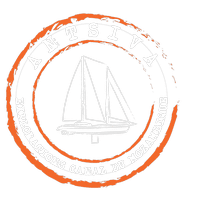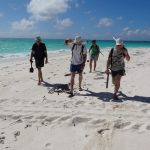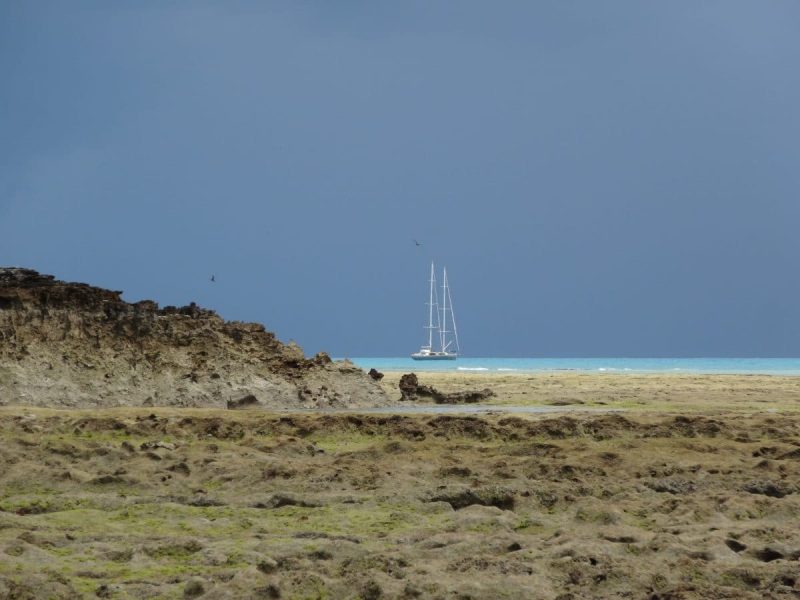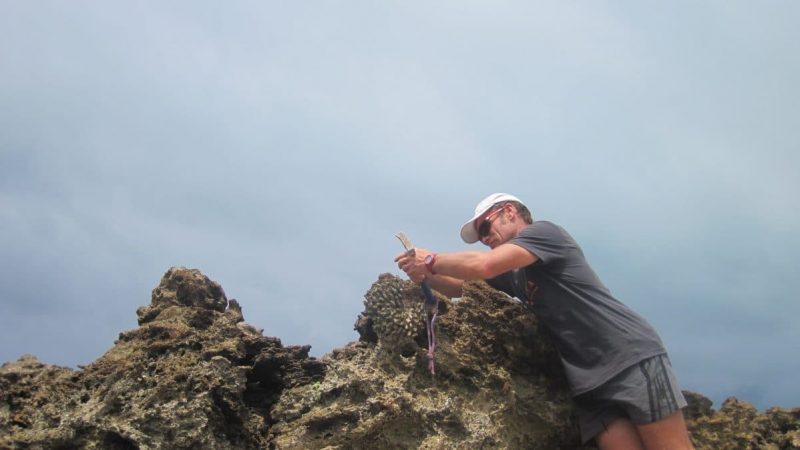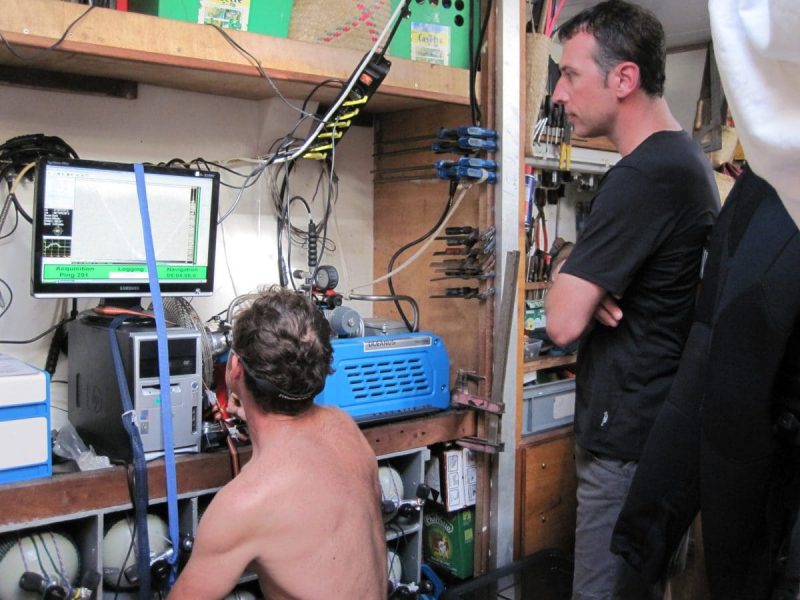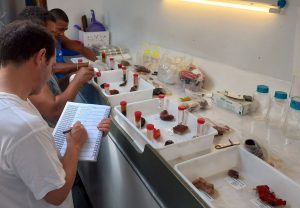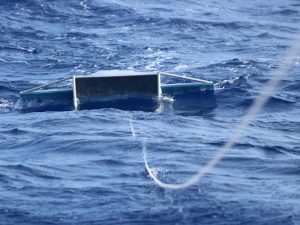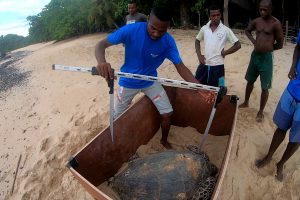Friday April 12th
A new team of scientists embark this morning aboard Antsiva. Stéphan, Gwénael and Sophie are all three geologists and work for Ifremer Brest.
Lou, cool Intechmerian, came to join us and will also participate in this expedition.
The program for this new mission consists mainly of acquiring seismic data from the Glorieuses lagoon and the Geyser bank. Sediments will be taken at the same time as well as samples of fossil corals.
At noon, everything is ready and we can sail. We weigh anchor towards Mayotte where we must first recover Pascal, the 4th geologist who is waiting for us with the equipment
A mission is never easy to mount. This one has not escaped the rule and Stéphan, as head of mission, had to show patience, ingenuity and a lot of tenacity to finalize this one.
One of the problems was the routing of equipment. The Taaf were not able to certify air transport to Glorious and transit through Madagascar was too risky. The last-minute solution was to send the crates by air freight to Mayotte with one of the members of the team.
We left for 36 hours of sea. It's a great first for Sophie who has never sailed! The crossing begins with the engine and gently on a calm sea, then the wind gets up and we can sail all the night.
Saturday, April 13
The wind is out of steam in the morning to resume again in the afternoon. Stomachs Sophie and Stephan sail and Gwenael is the only scientific guest valid for dinner. At midnight we enter the Mayott lagoon. 25 knots of wind and a strong enough sea accompanies us.
Sunday, April 14
We immediately contact Pascal who is waiting for us at the hotel. He embarks and puts his bag on board. The team is now complete. As it is Sunday, we can not yet recover the crates of material. It is therefore a day of development where everyone takes his marks. In the evening, around a capeirina, Stéphane explains the purpose of the mission. He introduces us to the work already done on the scattered islands and also exposes the next major project that will cover the entire Mozambique Channel. Then it's Sophie's turn to present her thesis.
If Lou apprehends well these subjects which she partly studied, we are for us totally neophytes in the matter and we familiarize ourselves with this new vocabulary: the seismic profiles, the currents of turbitude, the flutes ...
This is indeed the first time that Antsiva performs a seismic mission and we are particularly curious and interested in these new implementations aboard the sailboat.
Monday April 15th
Very active day. Above all, it is necessary to carry out the administrative formalities. As we plan to leave again the same evening, we save time by completing check-in and check-out at the same time.
Then the scientists get in touch with the freight forwarder and at the end of the morning the material is cleared and the crates loaded on board. The team is eager to open and unpack the equipment.
The PC that retrieves the seismic data is installed in the cargo hold as well as the power unit that will produce the 4000 volt electrical discharges. The screen and the computer are securely moored. The sediment grab is mounted and first tests are made at anchor Dzaoudzi. Finally, the two seismic cables (a transmitter, a receiver) are installed and rolled on the bridge on each side of the bar.
At 17 hours, everything is operational and we leave Mayotte in the direction of our first stage: the Geyser bench.
Tuesday April 16th
At 5 o'clock in the morning, we arrive at the bench of the Zélée and everyone is already at work because the seismic program begins. The generator is started, the two cables are put into the water, and the power unit switched on. It is she who delivers electric sparks at the end of the transmitting cable. The second cable receives the echoes and transmits them to the PC as graphics or "seismic profiles".
It works !! and it works very well because even the engine, there is little noise. Thanks to the shape of its hull, its particular propellers and its machine insulation, Antsiva is an excellent seismic sailboat.
And TIC TIC begin ... These famous little Tic Tic who will rock our days and will make us jump if we do not hear them anymore!
Pascal takes his place in the cargo hold facing the screen and monitors the arrival of the data. It also adjusts the instruments according to the height of the water.
So we start the first profile on the bench of the Zealous and continue all day by crisscrossing the interior of the lagoon at a constant speed between 4 and 5 knots. Around 16h, after 11 hours of "traine" and "tic-tic", a first loop is cordoned off and we are anchored near the island of white sand.
The day was very hot and the prospect of a snorkel in the aquarium of the blue hole is very tempting. But a threatening grain forces us to give up our bath and return to the boat. Pascal just had time to collect a scoop of sand on the famous island.
In the evening, Gwénael, studious starts working on his computer to release the first interpretations of the profiles, but the evening does not extend very long because a good tiredness falls on the whole team.
Wednesday April 17th
It's the second and last day at Geyser, it's about maximizing it. Rise early in the morning, and start with the sediment bins.
This is a bucket system that is lowered from the Antsiva Bridge into the open position. The impact with the ground triggers a powerful spring that closes the jaws of the bucket and fills the bucket with sediment. It is necessary then to go up the bucket. We use for this a hoist which one fixed at the end of the mast of load. From the first tests, adjustments are needed. The rope that is supposed to go up the bucket is too elastic and requires an incredible energy expenditure. We change then to take a dyneema halyard from Antsiva. This halyard has an almost zero elasticity, the ascent of the bucket begins therefore from the first crank but the manipulation remains sporting! After a few attempts to get back to the winch, it is more efficient to shoot live on the halyard. For this, two scientists throw themselves with all their weight on the hoist and pull to go up the bucket as glazed as possible. This maneuver particularly pleases Pascal who lacked physical activity and took the opportunity to let off steam ...
The results of the buckets are more or less satisfactory depending on the throws. Sometimes the bucket goes back completely empty or with only a few grains of sand. Sophie records the GPS point of each run and collects the contents of the skips in labeled bags. This sand will then be dried, then each grain will be analyzed and classified according to its nature.
Around us, the sky is loaded with big black apocalyptic clouds and huge grains encircle us. Suddenly, the flood falls on Antsiva and it is under a torrential rain that the team puts the cables in the water to start a new series of seismic profiles.
Time is running out for a possible coring of the second Geyser sand island and scientists prefer to continue the seismic survey of the area. Evening is falling, it is now dark night and in the wake of Antsiva a small flash sparkles at the end of the cable starboard, and always this incessant tic-tick ...
Finally, around 20 hours, we go up the cables and leave the Geyser to continue our route to Glorieuses.
Thursday 18 April
Arrival at the Glorieuses in the early morning. Smells of wet earth and vegetation tickle my nostrils. The sun is not yet high enough to illuminate the lagoon with its bright turquoise color.
The soldiers are warned of our arrival and are waiting for us. The team dismounted for a first contact with the gendarme, then they left to the north of the island to make two sand cores.
The afternoon is devoted to seismic in the lagoon bottom. For this Antsiva has raised its keel, its draft is reduced to 1.2 meters, which allows to navigate the shallow waters safely.
Friday April 19th
The weather tells us that the sea and wind conditions for the next few days will deteriorate.
The team then decides to take advantage of the good weather present to make the maximum seismic possible. It is therefore a day entirely devoted to seismic, a day spent traveling the lagoon according to a precise grid established by geologists.
From 7h to 19h, or for a good dozen hours, we drag the cables. From time to time, I pass a head in the hold to look at the screen that tirelessly records the profiles. Sometimes Pascal exclaims because he noticed an interesting feature. Everyone comes running and I too, but I must admit my ignorance because I see then only superimpositions of more or less horizontal features that do not evoke me much!
Scientists take turns in front of the screen because it must be said that this monitoring can sometimes take turns a little soporific. Come on, who did not dare a little nap in the hold, rocked by the sound of tic tic ...
Saturday, April 20th
The weather was not wrong, the wind is strong in the morning. It is impossible to leave the mooring and go off shore to make seismic in these conditions. Scientists then schedule a day of work ashore.
In the morning, two cores are taken at the northern tip of the island. We follow them to observe their handling. If the penetration of the corer does not pose any difficulty, it is not the same to remove it from the sand because it is important not to lose the deepest sediments.
Then the team goes to the reef outcrops in front of the military camp. Coral fossils are particularly well preserved and scientists collect samples, including a magnificent fossil clam.
Sunday, April 21, 2013
This morning, the particularly clear water invites to a morning bath and a snorkel around the boat. Turtles and many fish live under the hull of Antsiva. We even have the chance to meet a magnificent eagle ray spreading its wings in front of us. large grains fall on Antsiva forcing the team to work indoors on the computers. The morning is very studious and the predicted coring is postponed.
Today is Sunday and the military kindly invited us to share their Sunday BBQ. We leave the edge around noon to join the camp. Due to the persistent grain, Nicolas prefers not to accompany us and stays on board.
The crossing of the coconut grove is always a pleasure and walking under the green shade of thousands of palm always impresses. Lunch is held in good humor and friendliness. Then the military organize a big petanque tournament involving Pascal, Stéphane, Gwenael and Lou. Everyone has their own way of throwing the ball, but whether it's Pascal's very stylish and academic style or Lou's bowling style, neither of them will earn points and our four participants will finish great last.
Between two petanque parties, the scientists have time to carry out a coring behind the beach of the camp.
Monday, April 22
This morning again the wind is blowing hard. We go out at sea to launch dumpsters but the swell is strong and maneuvers become difficult. In addition, the skips go up desperately empty as if they touched only a slab of rocks while the bottom is sandy. After a good dozen unsuccessful attempts, we return to anchorage, a little annoyed but the team did not say his last word!
In the afternoon, the wind is still blowing. As the GPS points of the buckets are not very deep, a small team goes into the annex and two people dive on these points to collect the sand. This time the sediment harvest is assured.
Meanwhile, aboard Antsiva, the other part of the team looked into the problem of the bucket and managed to improve its operation.
Tuesday, April 23
The weather more lenient allows us to consider a new day of seismic. And this time, we are determined to test seismic sailing. Of course, the conditions of navigation do not allow it often because it is necessary to keep a constant speed and a very precise heading, but when we have a big bearing edge, we hoist all the sails and it is in silence that Antsiva drags proudly his two cables in his wake. And on the PC? the result is particularly convincing. No more parasitic noise and a beautiful profile very clear on the screen. Scientists are very enthusiastic and we are rather satisfied. Especially since tonight, the entire program of seismic is complete. The scientists got the desired results from all the profiles they wanted. Come on, capeirina for everyone!
Wednesday, April 24
Today, the wind is starting to blow again. The team dismounted to organize with the Constable the storage and return of crates of equipment by plane. While they go to make a coring, we take advantage of a walk to earth following the central track and we savor once again the pleasure to walk in the cocoterai.
In the afternoon, despite the wind, we make another attempt to launch skips. The new setting works perfectly. On the first four points of launch, the bucket rises full of sediments. But as we move away from the island we experience a strong swell and the handling of the bucket becomes dangerous. Stephan prefers to stop and return to anchorage.
Thursday, April 25
Today, the team has planned a sample collection work on the island of Lys. The gendarme and 3 soldiers also board Antisva because they intend to make an inventory and possibly a cleaning.
We arrive at the anchorage of the island of Lys in the morning. The sky is gray and heavy storms surround us. Everyone goes down to the ground. Just arrived on the beach we fall on the remains of a fishing camp. Old disemboweled mattresses, cans, plastic bottles and piles of rubbish litter the area.
In recent months, the Malagasy have intensified the sea cucumber fishery and come almost regularly install their camp on the island of Lys. This fishing is of course strictly prohibited but as long as there will be Chinese to pay a fortune each sea cucumber ... there will be Malagasy to pick them up!
We follow the scientists in their tour of the island. We first cross a dying mangrove. All the trees are dead and throw their long, knotty arms to the sky. Sad mangrove! Then we access the famous outcrops on the north coast. This part of the island consists of fossil reef terraces. Stéphane explains that this reef became fossil about 120 000 years ago, date of the last descent of the waters. What we have seen so far as ordinary sharp rocks now takes on another meaning and we now admire the finely serrated forms of these dead corals so long ago.
Scientists "hit the pebble", collect, carefully bag and scrupulously label each sample.
Meanwhile, the military burns litter from the beach and survey the island.
Around us, the sky becomes more and more dark creating for a moment an almost unreal picture where it is difficult to distinguish the magical from the menacing and in which the turquoise so bright of the lagoon is reflected in the gray so dark clouds.
We quickly get back to the boat, letting the crew finish their work on the outcrops.
After the brief picnic on the beach, Nicolas brings the scientists into the pool hole for a sediment sampling, then on the sandbar for a last coring. Obviously, not all cores have this panache but it must be admitted that it was worth being photographed! I
Back at anchor, we enjoy a calm sea to begin the unloading of the heavy boxes that will be stored at the camp. A team of soldiers is there to help with the maneuvers.
Friday, April 26
We have just spent 10 days at Les Glorieuses, it is time to weigh anchor and to return home. At 11 am, we leave the anchorage with a good wind up close. Unfortunately, after 4 hours of beautiful sailing, the wind crashes completely and it is the engine that we finish our crossing.
Saturday, April 27
Morning arrival on Nosy be. We land the team on Ambatoaloka beach where their hotel is located. We join them around noon to share a last lunch.
